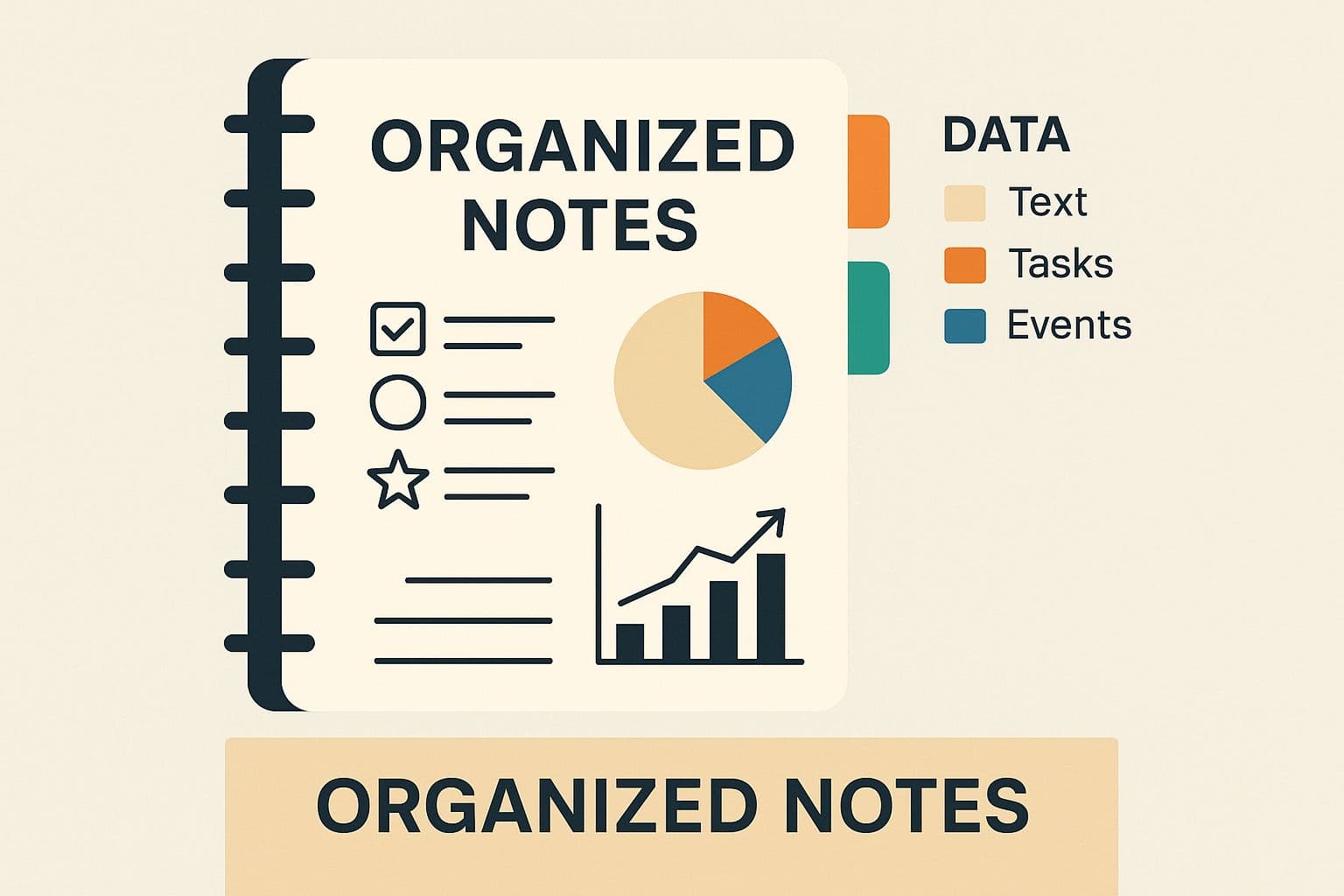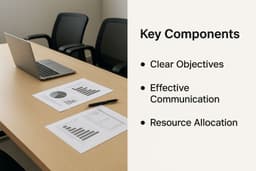Taking great notes isn't about writing everything down. It’s a three-part skill: prepare before the meeting, capture the important stuff during it, and organize everything so it’s actually useful afterward. Once you stop trying to transcribe every word and start using this approach, your notes will go from a messy record to a real tool that creates clarity and keeps everyone accountable.
Why Your Meeting Notes Aren't Working

Let’s face it—most meeting notes are a mess. We’ve all been there: you leave a meeting with pages of frantic scribbles but walk away with no real clue what to do next. This usually happens because we fall into the trap of just recording what's said instead of actively listening for what actually matters.
The problem isn't that you’re not writing enough; it's that you’re capturing the wrong information. Trying to document the entire conversation verbatim is a surefire way to burn out, and it leaves you with a wall of text that's impossible to use later on. More importantly, it pulls your attention away from listening and participating in the actual discussion.
From Court Reporter To Strategist
To really level up your note-taking, you need a mental shift. Your job isn't to document the conversation but to pull out the actionable intelligence from it. Think about the outcomes. Studies have shown that unproductive meetings are a massive headache for executives, and it's almost always because there was no clear purpose or follow-through. Your notes are what connect the discussion to real action.
So, what should you focus on? It boils down to a few key things:
- Decisions Made: What did the team officially agree on?
- Action Items: Who is doing what, and what’s the deadline?
- Key Questions: What’s still up in the air and needs an answer?
This simple framework helps you capture what’s essential for moving forward.
The Three Pillars of Actionable Note-Taking
To make this even clearer, I’ve broken down this strategic approach into three distinct phases. Each phase has a specific goal that builds on the last, turning a simple task into a powerful process.
| Phase | Key Objective | Example Action |
|---|---|---|
| Preparation | Set the stage for focused listening and capture. | Review the agenda and create a note template with key topics ahead of time. |
| Capture | Filter the conversation for high-value information. | Listen for trigger phrases like "We've decided to..." or "I'll take that on." |
| Organization | Make notes scannable, shareable, and actionable. | Clean up your raw notes and highlight all action items with owners and due dates. |
By mastering these three pillars, you ensure that the time spent in meetings translates directly into progress.
Set the Stage Before the Meeting Begins
Believe it or not, the secret to great meeting notes has almost nothing to do with what happens during the meeting. It’s all about what you do in the few minutes beforehand.
Walking into a meeting cold is like trying to cook a new recipe without glancing at the ingredients first. You might end up with something edible, but it’s going to be a messy, stressful process. The real work happens before the heat is on.
So, what’s the biggest culprit behind unproductive meetings? A lack of a clear agenda. It’s a shockingly common problem. Research shows that only 37% of meetings come with an agenda, and 61% of C-suite execs point to that as the main reason meetings go off the rails. You can dig into more meeting productivity statistics to see just how deep this issue runs. When you do get an agenda, use it.
Figure Out What
Before you join the call or walk into the room, take five minutes. Look at the agenda and ask yourself a simple question: “What do I personally need to get out of this conversation?”
Your answer will be different from everyone else’s. You might need a final decision on a project that’s stalled. Maybe you need a technical spec clarified, or you just need to know who is responsible for the next step and by when.
Writing these personal objectives down is like giving your brain a cheat sheet. It primes you to zero in on the information that actually matters to you. This tiny habit flips a switch, turning you from a passive listener into an active participant on a mission.
Here’s a quick way to frame your thoughts:
- Scan the Agenda: Who’s talking about what? Get a feel for the flow.
- Prep Your Questions: What are the 2-3 things you absolutely must have an answer to?
- Define Your Goal: What specific information or decision do you need to leave with?
This isn't about creating more work; it's about making the meeting work for you. You stop just reacting to the conversation and start steering it toward what you need.
Get Your Note-Taking Space Ready
Never, ever start with a blank page. Whether you're using a tool like Notion or a classic paper notebook, set up a simple template before the meeting starts. This little bit of structure saves you from the frantic scramble of trying to organize your thoughts while three people are talking at once.
Your template doesn't need to be fancy. Just creating a few dedicated spaces ahead of time makes a world of difference.
Try including these basic sections:
- The Basics: Meeting title, date, and who’s there.
- Agenda Items: Just copy and paste them from the invite.
- Decisions Made: A clean spot to log any final agreements. No more "I think we decided..." later.
- Action Items: The most critical part. A space to capture who is doing what, and by when.
With a prepped canvas, you walk into the meeting feeling calm and in control. You're no longer just a scribe trying to keep up—you're a strategist, ready to capture what matters from the very first minute.
Capturing What Actually Matters During the Meeting
Alright, the meeting is underway and ideas are flying. This is the moment most people trip up. They try to act like a court reporter, furiously scribbling down every single word. That’s a recipe for burnout, and frankly, it's not very helpful. Your job isn't to create a perfect transcript; it's to act as a filter, pulling out the gold from the conversation.
To do this well, you need to tune your ear for specific trigger phrases. Think of them as signposts that scream, "Hey, this is important—write this down!" When you focus on these cues, your notes become less about quantity and more about quality.
Listen for Action and Ownership
The most critical information in any meeting is about what happens next. So, instead of getting lost in the weeds of the general discussion, laser-focus on commitments. You're hunting for moments when a decision is made or a task is handed out.
Here are the kinds of phrases that should make your ears perk up:
- Decisions: "Okay, we've decided to move forward with..." or "The final call is..."
- Action Items: "I can take that on," or "Let's have [Name] be responsible for..."
- Deadlines: "...and we need that done by EOD Friday," or "The target date for this is..."
When you hear one of these, your only job is to capture the "who, what, and when" with absolute clarity. A vague note like "talked about marketing budget" is useless. A great note is "Sarah to send the final Q3 budget proposal to the team by Wednesday." One is noise; the other is an instruction.

This kind of structured approach, with clear symbols and organization, makes sure nothing important gets buried.
Find a Note-Taking Method That Works For You
Everyone's brain is wired differently, so what works for your colleague might not work for you. The key is finding a system that lets you capture information quickly without losing the thread of the conversation.
Here’s a quick rundown of a few popular methods to see which one might click.
Note-Taking Methods Comparison
| Method | Best For | Key Advantage |
|---|---|---|
| The Cornell Method | Structured, academic, or technical meetings. | Forces you to summarize and pull out key questions, which is great for retention. |
| Mind Mapping | Brainstorming and creative sessions. | Visually connects ideas, showing relationships that linear notes might miss. |
| The Quadrant Method | Fast-paced, action-oriented meetings. | Divides your page into four simple sections (e.g., General Notes, Actions, Questions, Key Decisions) for quick sorting. |
Experiment with these and see what feels natural. You might even end up creating a hybrid system that's all your own. The goal is clarity and speed, not following a rigid formula.
Develop Your Own Shorthand
Let’s be honest, conversations move fast. Trying to keep up by writing everything out longhand is a losing battle. This is where a personal shorthand system becomes your secret weapon. You don’t need to learn a whole new language—just a few consistent symbols will do the trick.
Make it intuitive and personal. For example:
- (D) = Decision Made
- [AI] = Action Item
- (?) = Question to Follow-up
- @ = Person Assigned (e.g., @Jessica to lead...)
- → = Deadline or Due Date (e.g., → Friday, Oct 25th)
Using simple shortcuts like these helps you keep pace with the discussion, so you can stay engaged instead of having your head buried in your notebook. And staying engaged is crucial. Research shows that 52% of employees lose focus within the first 30 minutes of a meeting. According to meeting engagement statistics from Flowtrace, effective note-taking is one of the best ways to stay locked in.
When you combine active listening with a simple shorthand system, you completely change the game. You'll walk out of every meeting with a clear, concise record of what was decided, who's doing what, and when it's due.
Turning Your Raw Notes into Actionable Steps
The meeting is over, but your job isn't done. Right now, you probably have a notebook full of scribbles, shorthand, and half-formed thoughts. That's just the starting point. The most important part of taking better notes happens right after you click "Leave Meeting"—turning that raw material into a clear plan.
Don't let your notes get cold. All the context and nuance of the conversation are fresh in your mind for only a short window of time. I always make it a rule to process my notes within 15-20 minutes of the meeting ending. If I wait until the end of the day, I'm almost guaranteed to misinterpret my own shorthand or forget a crucial detail someone mentioned offhand.
The Quick Review and Refine Process
Okay, first things first: clean up the mess. This isn't about rewriting everything from scratch. It's about pulling out the valuable bits and making them understandable to someone who wasn't in the room (which might just be you in two weeks).
Scan through your notes with one goal in mind: extracting value. In my experience, any productive meeting really only produces two things that matter.
- Key Decisions: What did the team actually agree to do? Write these down as simple, undeniable statements. For example, "We've decided to postpone the Q3 campaign launch to October 15th." No ambiguity.
- Action Items: This is the big one. Hunt down every single task that was assigned. A task without an owner and a deadline is just a wish, and it's your job to nail it down.
Once you've got this distilled version, it's time to share that clarity with the rest of the team. This is how you make sure everyone is on the same page and, just as importantly, create public accountability.
Distribute a Simple Follow-Up
You don't need to draft a formal, multi-page report. Honestly, no one will read it. A quick summary sent in an email or a shared Slack channel is almost always more effective. By doing this, you become the person who ensures things actually get done.
Keep the follow-up incredibly simple and scannable. Here’s a structure I've used for years that works like a charm:
- Start with a Quick Thank You: Just a brief line acknowledging everyone's time and contribution.
- List the Key Decisions: Use bullet points so people can scan them in seconds.
- Outline Action Items Clearly: This is where you need to be crystal clear. I like a simple table or a list with three columns: Action, Owner, and Due Date.
For instance, your action items section might look like this:
| Action | Owner | Due Date |
|---|---|---|
| Send final Q3 budget proposal | Sarah | EOD Friday |
| Schedule follow-up with the design team | Mark | Monday AM |
This quick post-meeting ritual is what transforms your notes from personal reminders into a powerful tool for team alignment and execution. It’s the final, crucial step in taking notes that actually drive action.
Common Note-Taking Mistakes to Avoid

Even the most diligent note-takers can fall into a few traps. Spotting these common slip-ups is the first step to making your notes genuinely useful after the meeting wraps.
The biggest mistake I see people make is trying to act like a court stenographer. You can't—and shouldn't—write down every single word. When you're frantically typing or scribbling, you stop listening to understand and start listening just to transcribe. You'll capture the words but completely miss the meaning behind them.
Another classic blunder is getting too clever with your shorthand. That funky symbol you invented on the fly might feel genius in the moment, but it becomes a useless squiggle when you can't remember what it means a day later. Keep it simple and stick to a system you know.
Vague Ideas vs. Concrete Actions
This is where the real value of a meeting often gets lost. Your notes become a jumble of interesting thoughts and brainstorming points, but there’s no clarity on what was actually decided or who is supposed to do what.
It’s a recipe for stalled projects and missed deadlines.
The fix is surprisingly simple: create a clear visual separation in your notes for two things:
- Decisions: What did the group officially agree on? Write it down as a final statement, not a suggestion.
- Action Items: Who owns the task, what is the exact task, and when is it due? Always capture the owner, the task, and the deadline.


